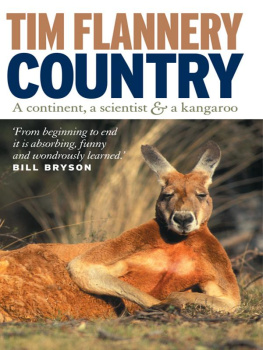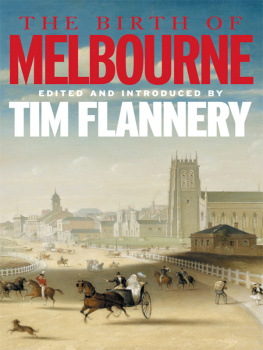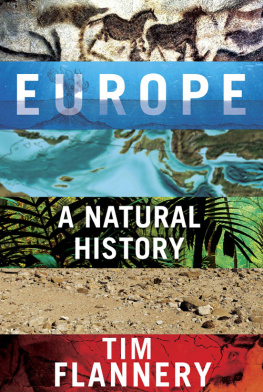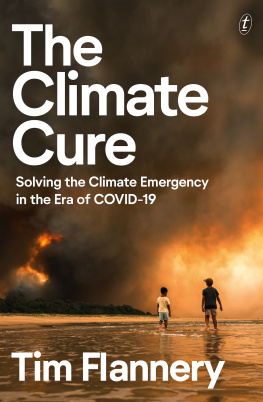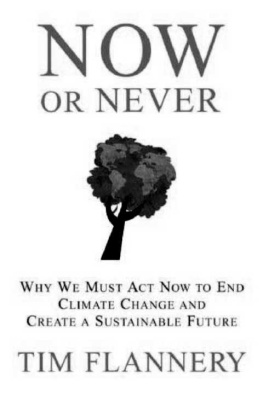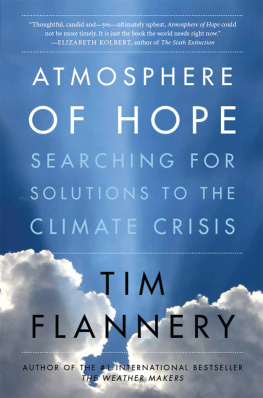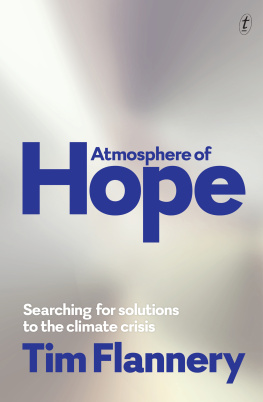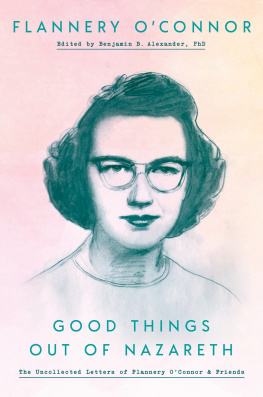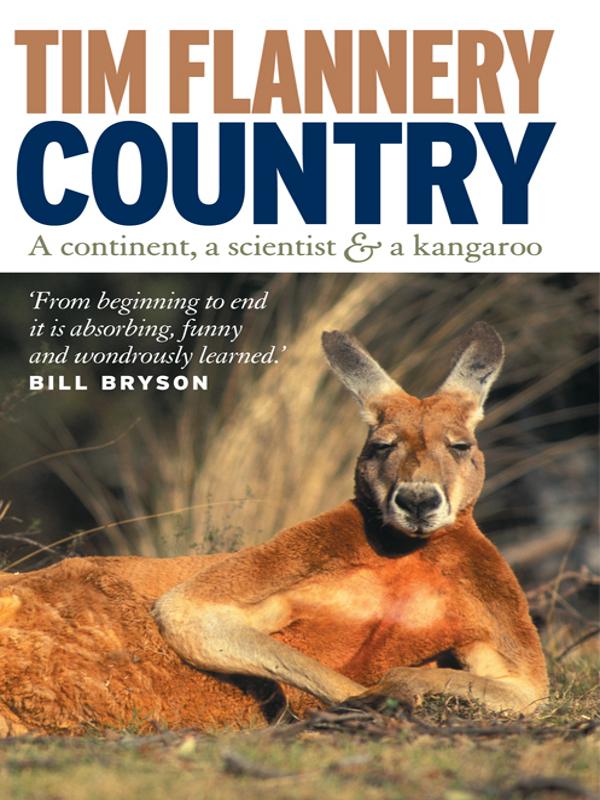
COUNTRY
Tim Flannery was born in Melbourne in 1956. He is director of the South Australian Museum, chair of the South Australian Science Council and has made contributions of international significance to the fields of palaeontology, mammalogy and conservation. He is also the bestselling and award-winning author of many books, including The Future Eaters and Throwim Way Leg.
OTHER BOOKS BY THE AUTHOR
Mammals of New Guinea
Tree Kangaroos: A Curious Natural History
(with Roger Martin, Peter Schouten & Alex Szalay)
The Future Eaters: An Ecological History of the Australasian Lands and People
Possums of the World: A Monograph of the Phalangeroidea
(with Peter Schouten)
Mammals of the South West Pacific and Moluccan Islands
Watkin Tench, 1788 (ed.)
John Nicol, Life and Adventures 17761801 (ed.)
Throwim Way Leg: An Adventure
The Explorers (ed.)
The Birth of Sydney (ed.)
Terra Australis: Matthew Flinders Great Adventures in the Circumnavigation ofAustralia (ed.)
The Eternal Frontier: An Ecological History of North America and Its Peoples
A Gap in Nature: Discovering the Worlds Extinct Animals
(with Peter Schouten)
John Morgan, The Life and Adventures of William Buckley (ed.)
The Birth of Melbourne (ed.)
Joshua Slocum, Sailing Alone around the World (ed.)
Astonishing Animals (with Peter Schouten)
The Weather Makers: The History and Future Impact of Climate Change
TIM FLANNERY
COUNTRY
A continent, a scientist & a kangaroo

ILLUSTRATIONS
Special thanks to Peter Schouten for his drawings and permission for picture reproduction. Stubbs kangaroo is reproduced with permission from the British Library. Other photographs reproduced with courtesy of Cindy Hann; Museum of Victoria; the authors own collection; and photographer Barry Wilson, reproduced courtesy of the Australian Wildlife Conservancy.
The Text Publishing Company
Swann House
22 William St
Melbourne Victoria 3000
Australia
www.textpublishing.com.au
Copyright Tim Flannery 2004
All rights reserved. Without limiting the rights under copyright above, no part of this publication shall be reproduced, stored in or introduced into a retrieval system, or transmitted in any form or by any means (electronic, mechanical, photocopying, recording or otherwise), without the prior permission of both the copyright owner and the publisher of this book.
First published 2004
This edition published 2005, reprinted 2006, 2009
Designed by Chong Wengho
Typeset by J&M Typesetting
Printed and bound by Griffin Press
Maps by Tony Fankhauser
National Library of Australia
Cataloguing-in-Publication data:
Flannery, Tim, 1956
Country.
Bibliography.
ISBN 1 920885 76 5.
1. Human ecology - Australia. 2. Aboriginal Australians
Social life and customs. 3. Australia - History. 4.
Australia - Description and travel. 5. Australia - Social
life and customs. I. Title.
919.4
To
my mother
Valda Joyce Flannery
a woman of boundless compassion and understanding
Contents
If you want to study the history of this country,
youll have to have the will to fail.
Tom Rich
When I was young I met a man whose arse bore the bite-mark of a Tasmanian tiger. David Fleay was one of Australias most respected naturalists, and hed received his punctures while bending over to film the creature as it paced in its cage in a Hobart zoo. In my youthful imaginings that scar was the supreme stamp of Australian identity, a badge of honour that lay forever beyond my reach. That was because my eyes opened on the world in Melbourne nineteen years, three months and three weeks after the last tiger closed hers forever.My birthplace was a grand, European-style city of rumbling trams, and men in coats trudging plane-tree-lined streets past Victorian bluestone edifices. I dreamed of finding a thylacine, but by the time I was old enough to travel, even kangaroos and bandicoots had vanished from around Melbourne. So I was a rebellious young mantoo angry to take a good look around mewho did not know my country.
Then again, how do you ever know your country? Had I not rejected what Id been taught at school I might have remembered the sage words: by their fruits you shall know them, and perhaps even recollected the First Fruits of Australian Poetry, a work that in 1819 eulogised the kangaroo, hailing it as
thou spirit of Australia,
that redeems from utter failure
this fifth part of the Earth.
The author of that first-published volume of Australian poetry was Justice Barron Field of the Supreme Court of New South Wales. Perhaps only one whose days were spent judging colonial miscreants could have rhymed Australia with failure. Then again, Ive always suspected that Australians are a self-deprecating people who, despite their penchant for scattering Great reefs, ranges and bights across the map, were ashamed of their country. Even our national symbol, the kangaroo, has been something of an embarrassment. Many people convert their national animal into haute cuisinevenison, wild boar or buffalo steakbut kangaroos are mostly fed to dogs.
The origins of the modern kangaroo industry illustrate how very low in the esteem of Australians the creature had fallen. It began in the 1960s when rabbit shooters, whose game had been ruined by myxo-matosis, were forced to search for an alternative. Australians had long welcomed the flesh of the pestilential rabbit to their tables, but they would not touch the kangaroo. So the creatures were shot for skins and the pet-food industry in numbersnearly nine million in 196667sufficient to threaten them with extermination. The impact of the slaughter prompted naturalist Vincent Serventy to lament that from the average persons point of view the kangaroo is now extinct. Nowhere can the average person see a live kangaroo within convenient distance from urban areas. In 1971, at the first meeting called to discuss the situation, the eminent zoologist Ronald Strahan captured the prevailing sentiment: I believe that kangaroo meat is only of commercial interest because it is cheap. The moment weput effort into its husbandry, we shall find that the game is not worth the candle.
It astonishes me that such a wondrous creature as the spirit of Australia could plummet so low in the nations affections, for our first published poet did not miss the mark in his eulogy. So breathtakingly different is the kangaroo that if it did not exist wed be unable to imagine it: hopping being as marked a departure from running as the orbital engine is from piston and crankshaft, and every bit as efficient. Perhaps familiarity has bred contempt, for unlike the thylacine, whose extinction has endowed it with mythic status, large kangaroos are today so commonplace that most Australians have long ceased to wonder at them. Some even regard them as pests.
Yet they are, in my opinion, the most remarkable animals that ever lived, and the truest expression of my countrynot because they appear on everything from the coat of arms to the national airline, but because they have been made by Australia. They are, in short, the continents most successful evolutionary product. Forged over eons by Australias distinctive environment, what was originally a tiny possum-like creature has endured a million genetic changes to become a kangaroo. In reading the animals history we should be able to discover, in distilled form, the story of our country.
Next page
